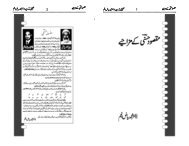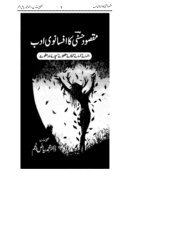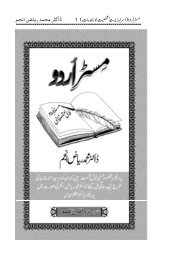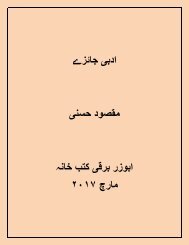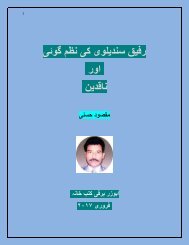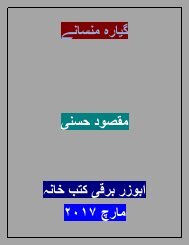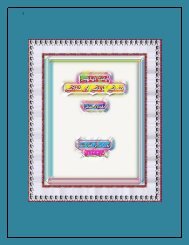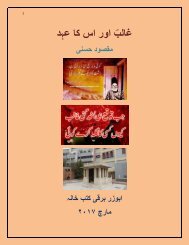Japani_ki_lisaniyati_Nazam_or_bhol_chal
You also want an ePaper? Increase the reach of your titles
YUMPU automatically turns print PDFs into web optimized ePapers that Google loves.
JPANI KA LASANIYATI NAZAAM AUR<br />
BOOL CHAL By Maqssoq Hasni<br />
130<br />
Compiled By: Dr. M. Riaz Anjum<br />
woh hai<br />
English<br />
I am<br />
He/she/it is<br />
You are<br />
They are<br />
We are<br />
This is<br />
That is<br />
<strong>Japani</strong> mein hoon, ho, hai, hain/is, am, are kay liay seraf<br />
desu ka estamal ho ga.<br />
Maslan<br />
Yah <strong>ki</strong>tna hai? How much is it? Ikura Desu ka?<br />
Aap/tuhara <strong>ki</strong>ya name hai? What is your name? O namae<br />
wa nan desu ka?<br />
Maira naam Qazi hai. My name is Qazi. Watashi no namae<br />
wa Kazi desu.<br />
Aap kaisay hain? How are you? O Gen<strong>ki</strong> Desu Ka?<br />
Kiya yah nazdeek (hi) hai? Is it close by? Chikai desu ka?<br />
I am crazy about you. Mein aap/tumharay moamlay main<br />
bara crazy hoon.<br />
Anata ni much? desu.<br />
Mein thek hoon. I'm (am) fine. Gen<strong>ki</strong> Desu.<br />
Japanese verbs<br />
These pages present a brief explanation of the grammar of<br />
the classical Japanese language, ie. the language of the<br />
Heian (794 - 1185) and Kamakura periods.<br />
Of course there were significant changes in the usage of<br />
the language during these centuries, so eg. the language of<br />
the Ise and Genji monogatari is the not the same as the<br />
language of Saigyou and Ryokan, but at this stage you can<br />
ign<strong>or</strong>e these differences.<br />
Verbs and adjectives can take many suffices, just as in<br />
modern japanese. Bef<strong>or</strong>e we discuss these suffices, it is<br />
imp<strong>or</strong>tant to understand the framew<strong>or</strong>k how they are<br />
attached to the verb.<br />
65<br />
JPANI KA LASANIYATI NAZAAM AUR<br />
BOOL CHAL By Maqssoq Hasni<br />
129<br />
Compiled By: Dr. M. Riaz Anjum<br />
"delicious"). The "root" adjective<br />
is oishi, and the -i ending is used since it's an -i adjective.<br />
(Note that not all adjectives ending in "i" are -i adjectives.<br />
See <strong>ki</strong>rei above).<br />
-i adjectives w<strong>or</strong>k like this:<br />
Oishii sushi (delicious sushi)<br />
Sushi wa oishii desu (the sushi is delicious)<br />
Sushi wa oishikunai desu <strong>or</strong><br />
Sushi wa oishiku arimasen (the sushi is not delicious)<br />
Sushi wa oishikatta desu (the sushi was delicious)<br />
Sushi wa oishikunakatta desu <strong>or</strong><br />
Sushi wa oishiku arimasendeshita (the sushi was not<br />
delicious)<br />
28-<strong>Japani</strong> esma<br />
<strong>Japani</strong> esma main <strong>ki</strong>si senaf, tadad, ya article <strong>ki</strong> waja say<br />
tabdili nahain aati wo apni halat barqarar rakhta hai.<br />
Girl, girls, The girl , a girl, some girls Onna hi estamal main<br />
aa’ay ga.<br />
<strong>Japani</strong> main esma <strong>ki</strong> jama <strong>ki</strong> Surat main <strong>ki</strong>siqisam <strong>ki</strong> tabdili<br />
nahain aati. Essay particles kahawala say wazay kar diya<br />
jata hai. Es ziman main chand particles ka estamal<br />
malahza ho:<br />
'Wa' indicates the topic<br />
'Ga' indicates the subject<br />
'O' indicates the object<br />
'No' indicates possession<br />
29-<strong>Japani</strong> Verbs<br />
<strong>Japani</strong> main tadad, Jins waghera kay hawala say tabdili<br />
nahain aati. Maslan<br />
Urdu<br />
Mein hoon<br />
Woh hai<br />
Tumm/aap ho<br />
Woh hain<br />
Hum hain<br />
Yah hai




